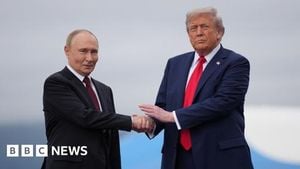In the waning months of 2025, the world is witnessing a remarkable shift in the global economic and political landscape, with the US dollar’s decline at the center of the story. For nearly two years, the greenback reigned supreme, buoyed by high Federal Reserve interest rates, global demand for safe-haven assets, and a steady undercurrent of geopolitical anxiety. But as autumn set in, the tide turned. The US Dollar Index (DXY), a bellwether that tracks the dollar against six major currencies, plunged more than 10% year-to-date, reaching lows not seen since 2021, according to IUX reporting.
This reversal is much more than a market correction. It signals deep, structural changes in the global order—changes shaped not only by economics, but by the long arc of history and the ambitions of rising powers. As the Federal Reserve, after more than a year of holding rates between 5.25% and 5.50%, began hinting at rate cuts for 2026, investors started looking elsewhere for higher returns. The result? Capital outflows from the US and a rebalancing of global financial flows.
According to the International Monetary Fund, the share of global foreign-exchange reserves held in US dollars has slipped below 58%, the lowest in over two decades. Countries such as China, Russia, and several members of the BRICS alliance have actively diversified their reserves into gold, the euro, and the Chinese yuan. This move is not just economic—it’s deeply strategic. As geopolitical fragmentation accelerates, many nations are seeking alternatives to the Western-dominated financial system, hoping to insulate themselves from future shocks and assert greater autonomy.
The consequences of this shift ripple far beyond currency markets. Gold, long considered a safe haven in uncertain times, soared above US$4,350 per ounce in October 2025—an all-time high. As IUX notes, “gold and other real assets are once again viewed as a hedge against currency depreciation and monetary uncertainty.” Meanwhile, the euro, Japanese yen, and Swiss franc have all appreciated, while commodity-linked currencies like the Australian and Canadian dollars are riding the wave of rebounding global commodity prices.
The weakening dollar has brought both relief and new risks for emerging economies. For countries saddled with dollar-denominated debt, a softer greenback lowers the real cost of repayment in local currencies—a welcome reprieve. But as history has shown, such benefits can be fleeting if market volatility returns or capital flows reverse suddenly. And because most global commodities, from oil to copper, are priced in dollars, a weaker USD usually means higher commodity prices—a boon for exporters, but a challenge for importers and consumers worldwide.
US-based multinationals are also feeling the effects. As foreign earnings convert into fewer dollars, profit margins are squeezed. On the flip side, non-US exporters selling into the American market find their products more competitively priced, potentially reshaping trade balances and investment flows. The global economy, in short, is in the midst of a significant recalibration.
The big question on everyone’s mind is whether this dollar downturn is just a blip, or the start of something bigger. Most analysts, according to IUX, believe the US dollar will remain the anchor of the global financial system for at least another decade, thanks to its unmatched liquidity, market depth, and the world’s enduring trust. But the signs of change are impossible to ignore. The world is moving—slowly but surely—toward a multi-polar currency system, one where the dollar remains dominant, but no longer unchallenged.
This view is echoed by political analysts and historians who see deeper forces at work. In a recent interview with IRNA, Velayati, a veteran observer of global affairs, traced the roots of US power back to the colonial ambitions of European nations in the 15th century. He argued that the United States was “established on principles of racial discrimination and colonialism,” and that its internal conflicts reflect “deeper economic and political divides.”
Velayati contended that after World War II, the US sought to position itself as the world’s sole superpower—a position quickly contested by emerging nations unwilling to accept unilateral dominance. He pointed to Russia’s resurgence under President Vladimir Putin and China’s meteoric rise as pivotal forces reshaping global dynamics, especially through strategic alliances like BRICS. “Russia’s resurgence and China’s rise are significant factors reshaping global dynamics through strategic alliances like BRICS,” he noted.
The US, Velayati claimed, now faces a legitimacy crisis not only in West Asia, but also in Latin America and East Asia, as it seeks to extend its influence. He was particularly critical of the Trump administration’s foreign policy, especially regarding Palestine, insisting that “the rights of the Palestinian people are non-negotiable.” In his view, the US aims to control regional energy and trade routes, exerting pressure on Pakistan and India, and seeking new military bases near Gwadar and Chabahar ports as a counterweight to China’s expanding footprint.
“Iran, as an independent and influential nation, plays a crucial role in the new global order based on justice and cooperation, standing firm against imperialism and supporting resistance movements,” Velayati asserted. This perspective is gaining traction in parts of the world where US power is viewed with skepticism, and where new alliances are forming to challenge the old order.
On the economic front, Europe has stabilized after its recent energy crisis, Japan has finally ended its long experiment with negative interest rates, and several Asian economies are reporting robust growth. These developments are encouraging investors to diversify away from US assets and reconsider the relative attractiveness of other markets. The focus, as IUX puts it, is shifting from “What will the Fed do next?” to “Where is global capital heading?”
For many, the dollar’s decline is more than a market event—it’s a signal of a broader realignment of global power. The weakening of the greenback could mark the opening chapter of a new monetary era, one defined by diversification, digitalization, and the decentralization of financial influence. As the world’s economic center of gravity shifts, the old certainties are giving way to a more complex, interconnected, and unpredictable global system.
Whether this transition will be smooth or turbulent remains to be seen. But one thing is clear: the story of the US dollar, and of American power more broadly, is entering a new and uncertain chapter—one that will be written not just in Washington and New York, but in Beijing, Moscow, Tehran, and capitals around the globe.




